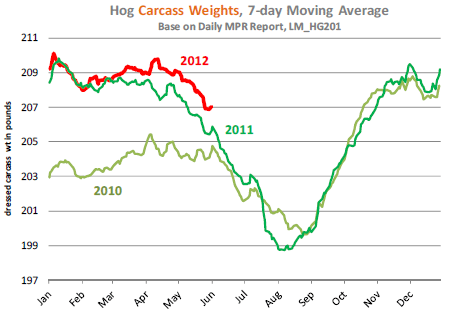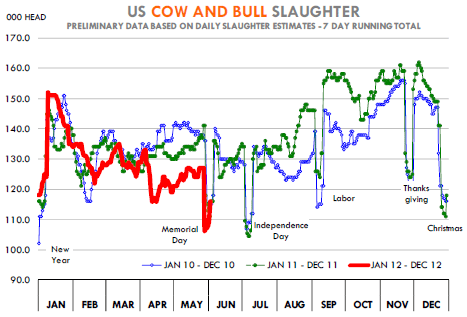



CME: Hog Slaughter Lower Than a Week Ago
US - Hog slaughter last week closed at 1.822 million head, about 12 per cent lower than the previous week due to the holiday shortened week but still some 4.5 per cent higher than a year ago, write Steve Meyer and Len Steiner.The short holiday week and indications that hog supplies
are very current helped fuel the surge in hog futures this past
week. The nearby June hog contract closed on Friday at $90.725/
cwt., almost 600 points or 7 per cent higher for the week. While there
was some talk in the market that sales over Memorial Day were
relatively good, we have yet to see any hard numbers confirming
that fact. Indeed, some items such as backribs which generally
tend to get some support from post-Memorial Day sales have declined
in value.
On the other hand, the market for hams remains
weak while pork trimmings continue to be very volatile, largely
due to extreme swings in the price of fat beef trimmings. There is
some talk that spot hog supplies have tightened up as producers
were very aggressive in marketing hogs during May, in part because
weights were running heavier than normal but also on concern
that the demand situation could deteriorate further. Hog
slaughter for the period 30 April - 2 June was 10.176 million head,
386,000 or 3.9 per cent higher than a year ago.
This is almost 1 per cent higher
than what the hog inventory survey implied in March. While we
could see USDA revise higher some of its inventory numbers at the
end of June, particularly the farrowing numbers, the heavier than
expected slaughter also may be explained by more aggressive marketings.
Hog weights, normally an indicator of currentness, continue
to be higher than a year ago but have started their seasonal
decline. We estimate based on the data in the mandatory price
reporting system that hog weights are currently running around
207 pounds per carcass, compared to around 209 pounds at the
beginning of May and yet higher than 205.6 pounds that they were
at around this time last year.

Cattle supplies continue to run below year ago levels.
Slaughter for the week was under 600,000 head (short holiday
week) and 2.5 per cent lower than the comparable week last year. Fed
cattle supplies remain relatively tight and steer and heifer slaughter
is currently running about 3 per cent below year ago levels. Cow and
bull slaughter which had been running as much as 10 per cent below year
ago in May was closer to the limited levels of last year. The expectation
is for cow slaughter to be near year ago levels in June.
This
is in part because June cow slaughter last year were relatively low
(see chart) but also because dry weather may push some cows to
market. While the drought situation in the Southern Plains has
improved, there continues to be drought pressure in the Southeast and in the Great Plains. Having said that, beef cow slaughter
overall should remain well below year ago levels.

As for dairy cow slaughter, it has been running well above last year but as corn prices pull back and milk values stabilize, this could also slow down the pace of dairy cow liquidation. Beef exports continue to hold strong, up 15 per cent from the comparable week last year. Cattle futures have gained in recent weeks but demand will likely face headwinds given weak economic data and a stronger US currency. Pent up demand coming into the grilling season has been supportive but the true test for cattle and beef prices will come in the dog days of summer.








